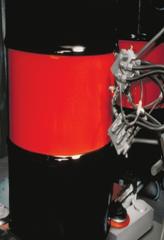Causes and conditions for flash rust during waterborne coating construction
Translation / Xin Qiaojuan
The cause of flash rust during the construction of waterborne anti-corrosion coatings seems to be inconclusive. There is a saying: "The flash rust problem of water-based paint refers to the rust phenomenon of the newly-applied water-based paint during the drying process. This phenomenon mainly occurs at the corroded interface or the newly activated steel surface. The occurrence of flash rust may occur. It is related to the dissolution and precipitation of iron compounds. The severity of flash rust depends on the coating system. Coatings such as polyvinyl acetate latex can prolong the contact time between water and substrate at low pH and low temperature and high humidity. Flash rust."
Of course, there are other different sayings: "The process of filming water-based paint has a process. Any piece of metal is not absolutely pure and absolutely smooth, so that a small block of different potentials will be produced. There will be current generation, and metal oxidation will occur to form rust spots, ie flash rust." It can be seen from these different statements that the generation of flash rust is an electrochemical process. Since the water-based paint itself is a conductor, a charge transport path is formed between different regions where a potential difference exists, so that corrosion occurs in a short time during the film formation process of the aqueous paint, and flash rust is formed. Obviously, the longer the wet paint film is kept, the more severe the flash rust phenomenon, which can explain the more serious flash rust phenomenon under low temperature and high humidity.
In fact, since flash rust is an electrochemical phenomenon, active metals placed in front of hydrogen will encounter this problem when using waterborne coatings. In the coating test of steel, cast iron, aluminum and aluminum alloy, galvanized sheet and other substrates, it is found that the situation of flash rust is generally: cast iron, aluminum, carbon steel, zinc plate (grinding), tinplate ( Grinding), iron or iron wire, aluminum alloy.
In many aspects of experiments and peers, cast iron is not only the most prone to flash rust substrate, but also one of the most difficult to solve the flash rust problem. The reason for this situation can be explained by the active condition of the metal and the purity of the material: the cast iron contains many impurities and complex components, and it is easy to form a cell with different potentials, so it is more likely to appear in the process of water-based paint construction. The situation of flash rust. However, limited to the author's level and experimental conditions, the above sorting requires more in-depth experiments and arguments.
Electrochemical phenomenon is the root cause of flash rust. However, the conditions for flash rust are very complicated during the construction of waterborne coatings. In addition to the difference in substrate discussed above, the pH of the coating, the temperature and humidity of the construction environment, the wind speed, the thickness of the paint film, etc., all have an effect on the flash rust phenomenon.

Moderation Board,Foldable Flipchart,Art Easel Stand,Digital Flipchart
Dongguan Aoxing Audio Visual Equipment CO.,Ltd , https://www.aoxing-projectorscreen.com
![<?echo $_SERVER['SERVER_NAME'];?>](/template/twentyseventeen/skin/images/header.jpg)